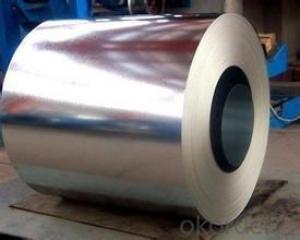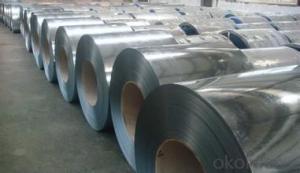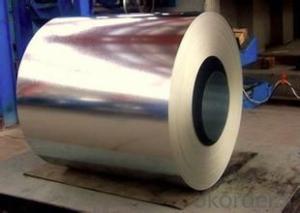hot-dip galvanized/ Aluzinc steel in good Quality
- Loading Port:
- Tianjin
- Payment Terms:
- TT OR LC
- Min Order Qty:
- 100 m.t.
- Supply Capability:
- 5000000 m.t./month
OKorder Service Pledge
OKorder Financial Service
You Might Also Like
Description:
Hot-dip galvanized steel coils are available with a pure zinc coating through the hot-dip galvanizing process. It offers the economy, strength and formability of steel combined with the corrosion resistance of zinc. The hot-dip process is the process by which steel gets coated in layers of zinc to protect against rust. It is especially useful for countless outdoor and industrial applications.
Production of cold formed corrugated sheets and profiles for roofing, cladding, decking, tiles, sandwich walls, rainwater protective systems, air conditioning duct as well as electrical appliances and engineering.
Specification:
1.Mateials:SGCC,DX51D / DX52D /S250,280GD
2.Size:width:600-1250mm(900mm,1215mm,1250mm,1000mm the most common)
thickness:0.15-2.0mm
length:1000-6000mm,as your require
3.Zinc coating :60-180g( as required)
4.Coil id:508mm
5.Coil weight: 3-5MT(as required)
6. Surface:regular/mini/zero spangle, chromated, skin pass, dry etc.
Applications :
Galvalume Coil widely used for roofing products, It is also the ideal base material for Prepainted Steel Coil.
1. roofing
2. gutters
3. unexposed automotive parts
4. appliances
5. furniture
6. outdoor cabinetry
Images:

- Q:What are the different methods of painting steel coils?
- There are several different methods of painting steel coils, each with its own advantages and applications. 1. Coil coating: This is a continuous and automated process where a coil of steel is unwound, cleaned, pretreated, primed, painted, and cured before being rewound. Coil coating offers excellent control over the paint application and ensures a consistent finish. It is commonly used for high-volume production of steel coils, such as in the automotive and construction industries. 2. Spray painting: This method involves manually or mechanically spraying paint onto the steel coils. It is a versatile and flexible method that allows for customization and precise control over the paint application. Spray painting can be done in various ways, such as airless spraying or electrostatic spraying, depending on the desired finish and the specific requirements of the project. 3. Dip coating: Also known as immersion coating, this method involves immersing the steel coils into a tank of paint. The coils are carefully lowered into the paint, ensuring that all surfaces are fully coated. Dip coating is often used for large or bulky steel coils that cannot be easily spray painted. It provides excellent coverage and can be suitable for certain applications, such as in the electrical or appliance industry. 4. Powder coating: This method involves applying a dry powder paint to the steel coils using an electrostatic process. The charged powder particles adhere to the grounded coils, creating a durable and even coating. Powder coating offers excellent resistance to impact, chemicals, and UV rays. It is commonly used in applications where a high-quality and long-lasting finish is required, such as in the aerospace or outdoor equipment industry. 5. Roll coating: This method involves passing the steel coils through a series of rollers that are partially submerged in paint. As the coils go through the rollers, the paint is transferred onto their surface. Roll coating is often used for thin or delicate steel coils, as it provides a gentle and uniform paint application. It is commonly used in the appliance or electronics industry. Each method has its own advantages and is chosen based on factors such as the desired finish, production volume, cost, and specific requirements of the project. Ultimately, the choice of painting method depends on finding the most suitable balance between quality, efficiency, and cost-effectiveness.
- Q:What are the different coil handling equipment options available for steel coils?
- There are several options available for handling steel coils, including coil cars, coil upenders, coil lifters, coil tilters, and coil transfer carts. These equipment options are designed to safely and efficiently transport, position, and manipulate steel coils during various stages of the manufacturing process.
- Q:is cold roll or hot roll mill roller is cast steel? or cast iron?
- Casting is a process of forming a part just like forging or rolling are also processes of forming steel. Cast steel can be any grade of steel poured into a sand mold to form a part like a water pump housing in your car. To be classified as steel, the mixture usually contains less than 2% carbon. Cast iron is a mixture that generally contains more than 2% carbon. It also can be poured into a sand mold. There are many grades of iron. Many metals can be cast into shapes like the air intake plenum on your car is probably cast aluminum. Bronze statues are made by pouring molten bronze into a mold. The process used to create a part has an effect of that part's mechanical properties. A casting is weaker than a forging but certain parts cannot be formed by forging. The large diameter rolls used in steel mills to roll steel into thinner plates or sheets is a hot rolled steel that has probably been forged into shape then machined into the final diameter. Some rolls are fabricated from hot rolled steel plates into shape. This allows the ability to add internal cooling paths to keep the roll from overheating.
- Q:what do they use to make stainless steel?and can stainless steel be melted again and again without losing it's Specifications
- Components Of Stainless Steel
- Q:I saw this really pretty ring online and it was made of steel. Is this a good ring? If I were to wash my hands with it on, would it rust and turn my finger green?
- Steel rust is brown not green! Very much expected to be of one type of stainless steel, and you should have no problem.
- Q:I understand that damascus sword steel was made by folding the strip of steele double , reheating, hammering, folding again and so forth hundreds of times. Was this the same or very nearly the same techmique the japs used making the sword blades the samari swords?(forgive the misspelling)
- The samari swords are made by folding to make many many alternating layers of different steel compositions. Damascus swords were made differently. The steel was heated and forged (like samari swords) but it was not folded. The patterns produced are due to the micro macro-structure of the steel alloy and the way the steel is forged. Fake Damascus steel knives and gun barrels and other items have been made by pattern welding (forge cladding steels with different compositions together) and then folding and forging with some tricks. google damascus steel and you will find lots of info. hope this helps
- Q:for my engineering project I have been asked to design a method of suspending a TV of weight 14Kg from a gantry, the TV must be 5m below the gantry. My team have decided to use as a suspension method a steel cylinder of outer diameter of 10cm and an inner diameter of 8, however we now need to work out both the max stress and strain and the actual stress and strain. and help would be useful
- the area of the cylinder bypass area is extensive actual its 28.26 cm^2 so if the wieght is 14 which ability the metallic consists of .5 kg/cm2 , which isn't something we enable metallic the gentle one carry as much as a million.4 t/cm2 that's 1400 kg no longer 0.5 , so dont worry urself approximately deflection....
- Q:How are steel coils inspected for elongation using elongation testers?
- Steel coils are inspected for elongation using elongation testers by first selecting a representative sample from the coil. This sample is then mounted onto the tester, which applies a controlled force to stretch the steel. The elongation tester measures the change in length of the sample as it is stretched, allowing the calculation of the elongation percentage. This data is crucial for evaluating the steel's ductility and mechanical properties, ensuring it meets quality standards and can withstand various applications.
- Q:How are steel coils used in the production of roofing materials?
- Steel coils are used in the production of roofing materials as they are rolled out and cut into specific lengths, forming the base material for roofing panels or shingles. These coils provide durability, strength, and resistance to weather conditions, ensuring long-lasting and reliable roofing solutions.
- Q:Can steel coils be used in the food processing industry?
- No, steel coils are not typically used in the food processing industry due to the risk of contamination and potential health hazards. Food-grade materials such as stainless steel are preferred for their hygienic properties and ability to withstand high sanitary standards.
1. Manufacturer Overview |
|
|---|---|
| Location | |
| Year Established | |
| Annual Output Value | |
| Main Markets | |
| Company Certifications | |
2. Manufacturer Certificates |
|
|---|---|
| a) Certification Name | |
| Range | |
| Reference | |
| Validity Period | |
3. Manufacturer Capability |
|
|---|---|
| a)Trade Capacity | |
| Nearest Port | |
| Export Percentage | |
| No.of Employees in Trade Department | |
| Language Spoken: | |
| b)Factory Information | |
| Factory Size: | |
| No. of Production Lines | |
| Contract Manufacturing | |
| Product Price Range | |
Send your message to us
hot-dip galvanized/ Aluzinc steel in good Quality
- Loading Port:
- Tianjin
- Payment Terms:
- TT OR LC
- Min Order Qty:
- 100 m.t.
- Supply Capability:
- 5000000 m.t./month
OKorder Service Pledge
OKorder Financial Service
Similar products
New products
Hot products
Related keywords






























